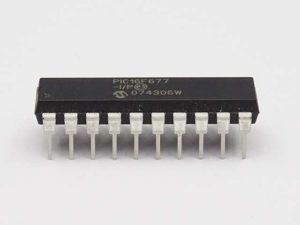 Break IC PIC16F677 Firmware
Break IC PIC16F677 Firmware
When Break IC PIC16F677 Firmware, through manipulate the clock source mode can successfully bypass the protection mechanism of MCU and read out the firmware;
Clock Source modes can be classified as external or internal.
· External Clock modes rely on external circuitry for the clock source. Examples are: Oscillator modules (EC mode), quartz crystal resonators or ceramic resonators (LP, XT and HS modes) and Resistor-Capacitor (RC) mode circuits.
· Internal clock sources are contained internally within the Oscillator module. The Oscillator module has two internal oscillators: the 8 MHz High-Frequency Internal Oscillator (HFINTOSC) and the 31 kHz Low-Frequency Internal Oscillator (LFINTOSC) to facilitate the process of MCU Cracking.
The system clock can be selected between external or internal clock sources via the System Clock Select (SCS) bit of the OSCCON register.

Break IC PIC16F677 Firmware
If the Oscillator module is configured for LP, XT or HS modes, the Oscillator Start-up Timer (OST) counts 1024 oscillations from OSC1. This occurs following a Power-on Reset (POR) and when the Power-up Timer (PWRT) has expired (if configured), or a wake-up from Sleep after Break Chip PIC12CE518 Binary. During this time, the program counter does not increment and program execution is suspended.
The OST ensures that the oscillator circuit, using a quartz crystal resonator or ceramic resonator, has started and is providing a stable system clock to the Oscillator module. When switching between clock sources, a delay is required to allow the new clock to stabilize.
These oscillator delays are shown in Table 3-1. In order to minimize latency between external oscillator start-up and code execution, the Two-Speed Clock Start-up mode can be selected t;mso-ansi-language: EN-US;mso-fareast-language:ZH-CN;mso-bidi-language:AR-SA’>(SCS) bit of the OSCCON register.
The External Clock (EC) mode allows an externally generated logic level as the system clock source. When operating in this mode, an external clock source is connected to the OSC1 input and the OSC2 is available for general purpose I/O. Figure 3-2 shows the pin connections for EC mode for the purpose.
The Oscillator Start-up Timer (OST) is disabled when EC mode is selected. Therefore, there is no delay in operation after a Power-on Reset (POR) or wake-up from Sleep. Because the PIC® MCU design is fully static to against Copy Microcontroller PIC16CR83 Heximal, stopping the external clock input will have the effect of halting the device while leaving all data intact.
Upon restarting the external clock, the device will resume operation as if no time had elapsed.